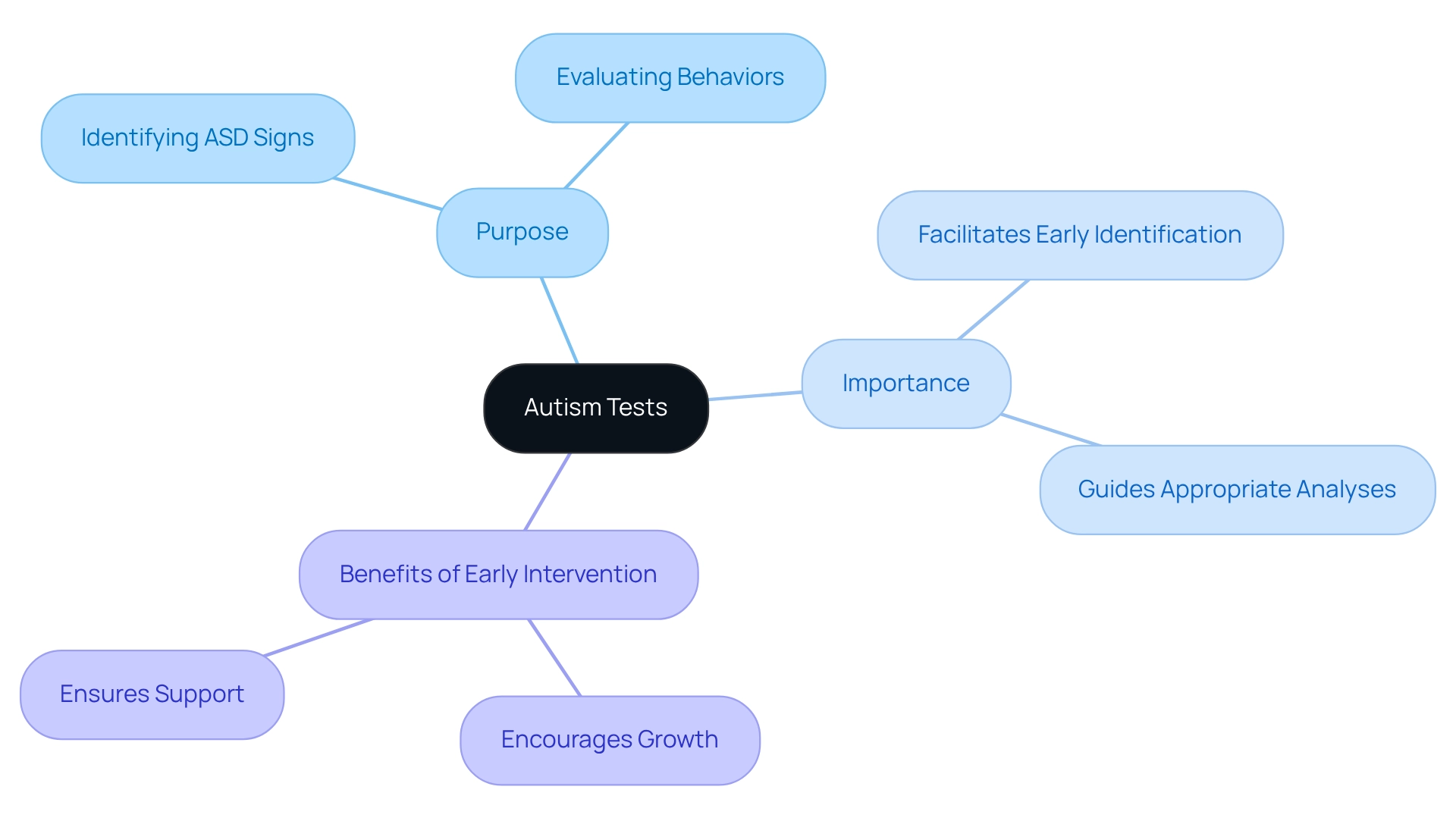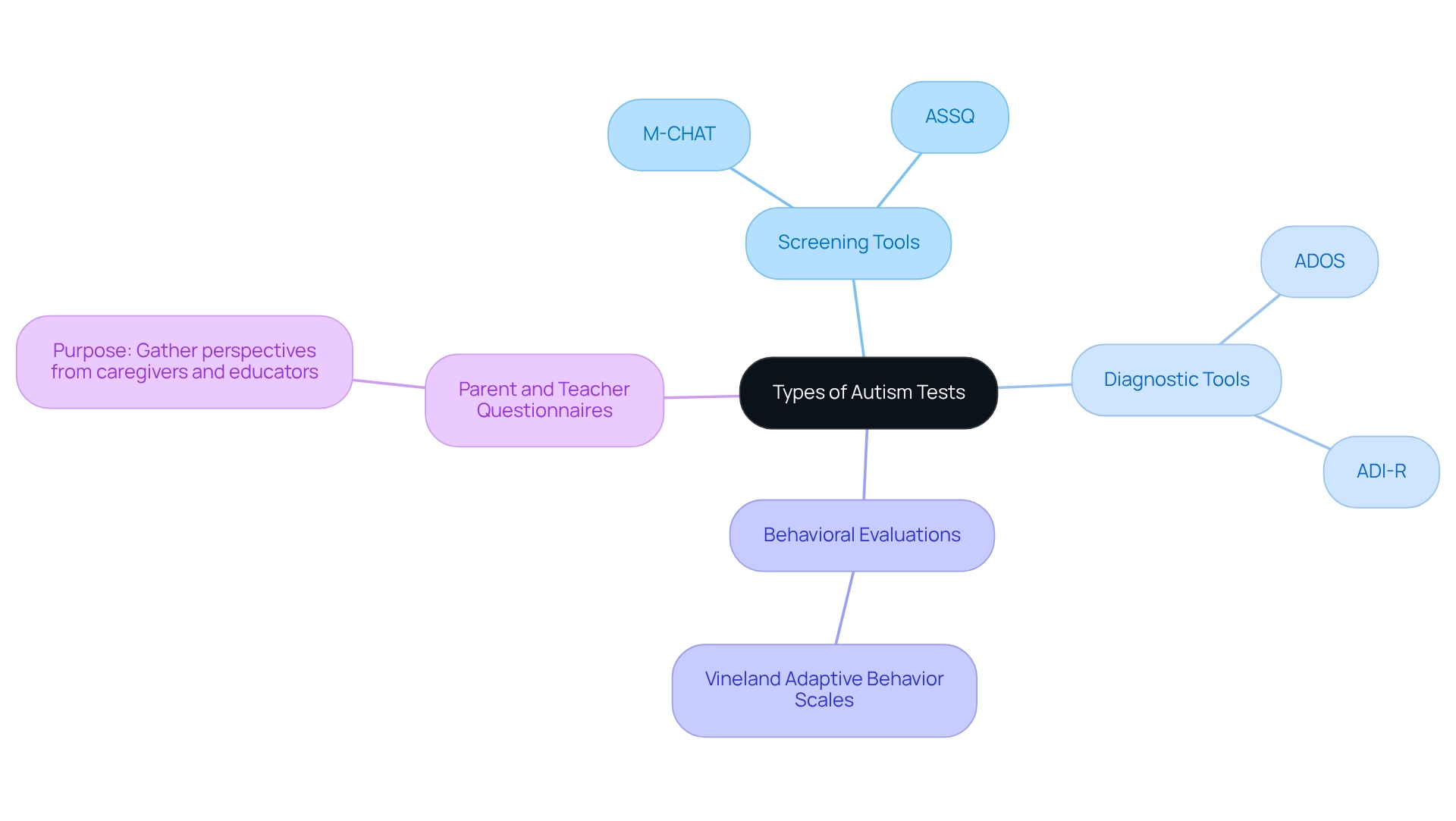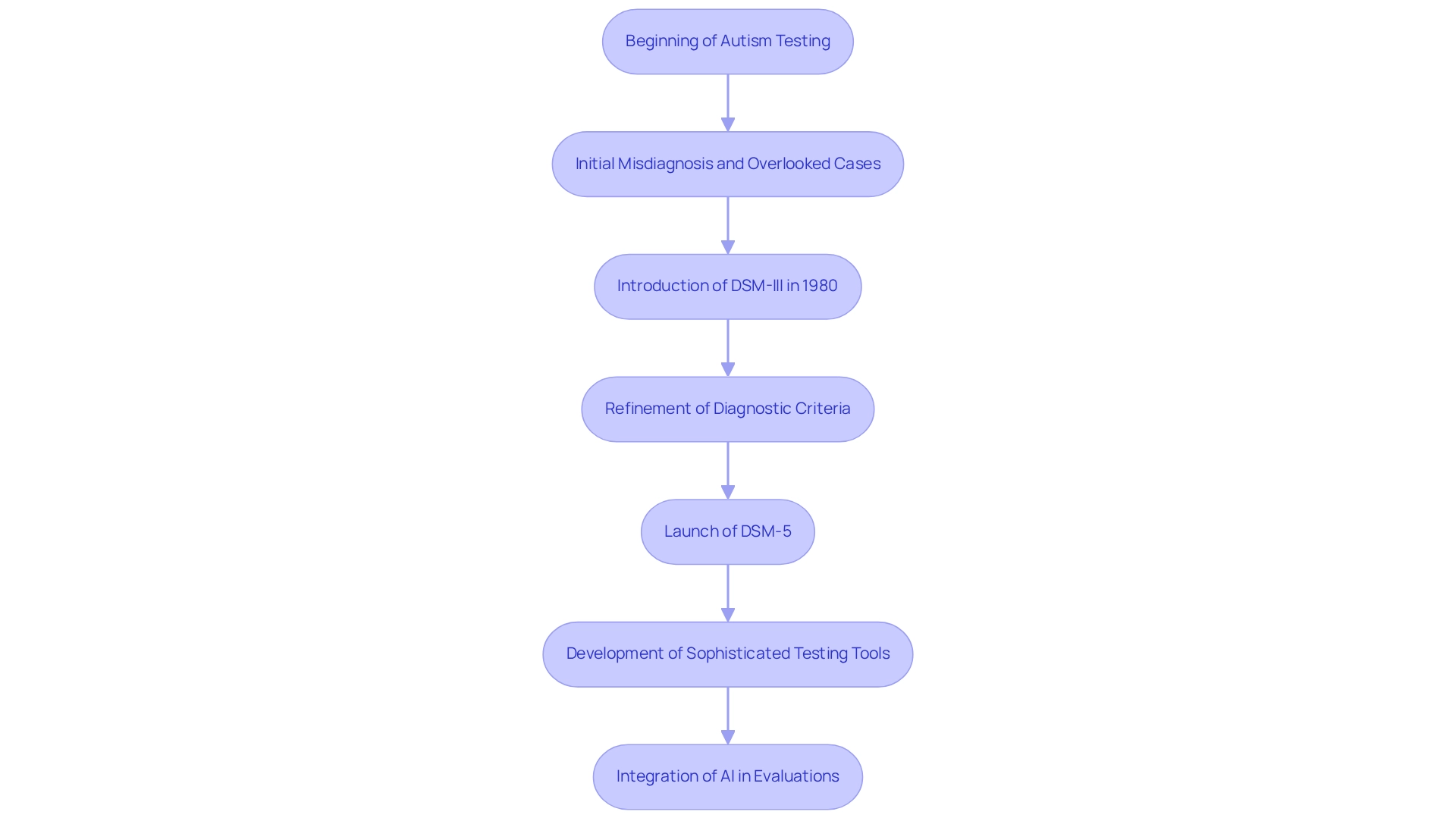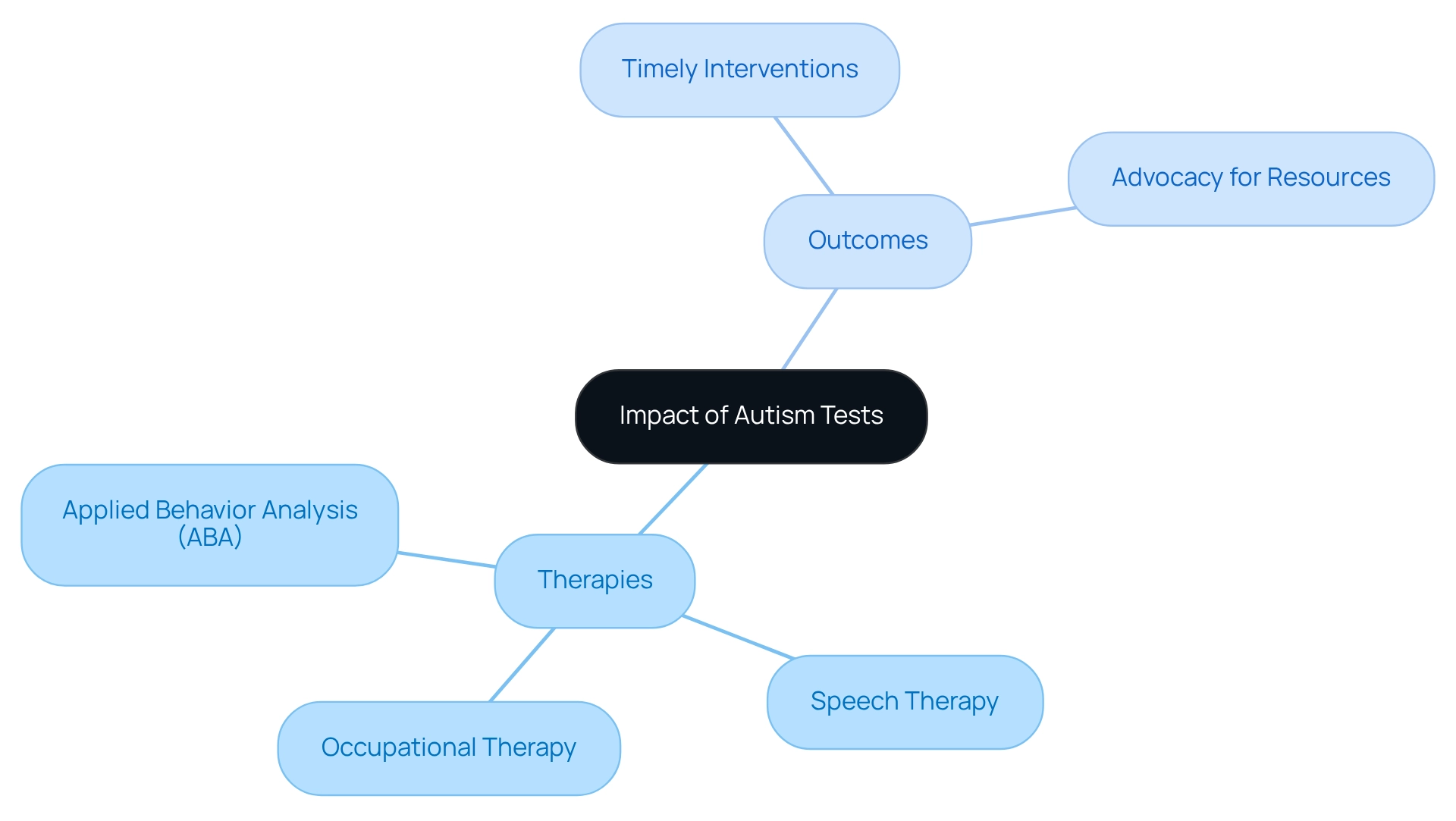Overview
This article delves into the various types of autism tests, shining a light on their crucial role in identifying and supporting individuals with autism spectrum disorder (ASD). By facilitating early diagnosis and intervention, these tests pave the way for improved developmental outcomes. Tailored support strategies and therapies can make a significant difference in the lives of those affected.
For parents navigating this journey, understanding the impact of these tests can be both enlightening and empowering. They not only help in recognizing the unique challenges faced by their children but also open doors to resources that can foster growth and development.
As we explore the purpose of these assessments, it becomes clear that they are more than just tools; they are lifelines that guide families toward the support they need. Together, let’s embrace the journey of understanding and advocating for our loved ones with ASD, ensuring they receive the care and attention they deserve.
Introduction
In a world where understanding autism is vital for creating inclusive environments, the significance of autism tests has never been more pronounced. These structured assessments not only assist in identifying autism spectrum disorder (ASD) but also open doors for timely interventions that can profoundly transform individuals' lives. From simple screening tools to comprehensive diagnostic assessments, a range of testing methods has emerged, reflecting the progress we've made in understanding autism.
Yet, despite their crucial role, challenges and misconceptions surrounding autism testing continue to exist, often obstructing access to essential support. It's important to delve into the purpose, types, evolution, and impact of these assessments. By doing so, we can illuminate their critical function in guiding effective intervention strategies and addressing the barriers that families encounter. Together, we can foster a deeper understanding and support system for those navigating the complexities of autism.
Defining Autism Tests: Purpose and Importance
Evaluations serve as organized procedures designed to help us understand if individuals show signs of spectrum disorder (ASD). These types of autism tests play a crucial role in identifying autism-related behaviors and characteristics, which can vary significantly from one person to another. Recognizing the importance of these types of autism tests is vital, as they facilitate early identification, allowing for timely actions that can profoundly improve outcomes for both children and adults on the autism spectrum.
For parents and specialists, understanding the significance of these types of autism tests can illuminate the path toward recognizing the need for appropriate analyses. It also highlights the potential benefits of early intervention techniques. By engaging in this process, we can foster a supportive environment that encourages growth and development, ensuring that individuals on the spectrum receive the care and resources they deserve.

Types of Autism Tests: An Overview of Assessment Tools
Evaluations play a vital role in the examination process, each serving unique purposes that can significantly impact individuals and their families. Understanding the different types of autism tests can empower parents and professionals alike to make informed decisions, with screening tools often being the first step. These brief evaluations help identify individuals who may benefit from further assessment. For instance, the Modified Checklist for Autism in Toddlers (M-CHAT) and the Autism Spectrum Screening Questionnaire (ASSQ) are commonly used to flag potential concerns early on.
Next, we have Diagnostic Tools. These comprehensive evaluations are conducted by skilled experts to accurately identify developmental disorders. Widely recognized tools, such as the Autism Diagnostic Observation Schedule (ADOS) and the Autism Diagnostic Interview-Revised (ADI-R), provide critical insights that can guide treatment and support.
Behavioral Evaluations focus on measuring specific behaviors related to social communication challenges. Assessments like the Vineland Adaptive Behavior Scales help us understand social skills and communication capabilities, shedding light on the individual’s unique strengths and areas for growth.
Finally, Parent and Teacher Questionnaires gather valuable perspectives from caregivers and educators about the individual’s behavior across different environments. This holistic view is essential for a well-rounded understanding of the child's functioning, especially when considering the various types of autism tests, as familiarizing ourselves with these evaluations can help us better navigate the assessment landscape and choose the most suitable tools for our needs. If you have experiences or thoughts on this topic, we encourage you to share them in the comments or through our newsletter. Your insights can help others on this journey.

The Evolution of Autism Testing: Historical Context and Developments
The evolution of testing for spectrum disorders represents a profound shift in our understanding of these conditions. Initially, many children faced misdiagnosis or were overlooked entirely, often due to a lack of awareness surrounding their unique characteristics. The introduction of the DSM-III in 1980 was a pivotal moment, offering clearer diagnostic criteria that helped illuminate the path forward. As our understanding has deepened, the criteria have been refined, culminating in the DSM-5, which unifies various diagnoses into the broader category of autism spectrum disorder (ASD).
This ongoing evolution has fostered the creation of more sophisticated testing tools, including types of autism tests, allowing for earlier and more precise diagnoses that can significantly impact a child's development. Moreover, advancements in research and technology, particularly the integration of artificial intelligence in evaluations, are shaping the future of testing for developmental disorders. These innovations not only enhance the accessibility of assessments but also improve their efficiency, ensuring that families receive the support they need in a timely manner.
As we continue to navigate this journey together, it's essential to stay informed and connected, sharing experiences and resources that can empower us all.

Impact of Autism Tests: Guiding Support and Intervention Strategies
The impact of types of autism tests extends far beyond mere diagnosis; they are vital in shaping effective support and assistance strategies. Thoughtful evaluations provide deep insights into a child's unique strengths and challenges, empowering experts to develop personalized support plans.
For example, the results from types of autism tests can assist families in choosing suitable therapies, such as:
- Applied Behavior Analysis (ABA)
- Speech therapy
- Occupational therapy
Moreover, early identification through these assessments can lead to timely interventions that significantly improve developmental outcomes. Families equipped with knowledge from evaluation results are better positioned to advocate for their children's needs, ensuring they receive the essential support and resources necessary for their growth and success.

Challenges in Autism Testing: Addressing Barriers and Misconceptions
Understanding the significance of developmental disorder testing is crucial, yet many challenges can hinder this process. Misunderstandings about the condition and its evaluation can lead to delays in seeking assistance. For example, some parents may believe that autism assessments are necessary only for children with pronounced symptoms, resulting in missed opportunities for early support. Furthermore, in certain areas, access to qualified professionals and appropriate testing tools may be limited, creating disparities in diagnosis and support.
To overcome these obstacles, it is vital for families to seek information from trustworthy sources and advocate for their children's needs. By building awareness around the importance of early testing and intervention, parents can feel empowered to take proactive steps in securing the necessary assessments and support for their children. Remember, every step taken towards understanding and addressing these challenges can make a significant difference in your child's life.

Conclusion
The exploration of autism testing highlights its crucial role in identifying autism spectrum disorder (ASD) and facilitating timely interventions that can greatly improve the quality of life for those affected. By grasping the purpose and significance of these structured assessments, families and professionals can better navigate the complexities of autism. From screening tools to comprehensive diagnostic assessments, each test serves a unique function, contributing to a deeper understanding of an individual's needs.
As autism testing has progressed, so has the sophistication of the tools at our disposal. Reflecting on its historical context reveals a journey from misdiagnosis to the establishment of clear diagnostic criteria, culminating in the advent of advanced assessments. This evolution not only enhances the accuracy of diagnoses but also opens the door to innovative approaches, including the integration of technology in testing practices.
Nonetheless, challenges such as misconceptions and accessibility issues remain significant barriers to effective autism testing. It is essential to confront these obstacles through education and advocacy, empowering families to seek the necessary assessments and support. By cultivating a deeper understanding of autism testing and its impact, we can work together to create more inclusive environments for individuals on the spectrum, ultimately leading to better outcomes and a brighter future for all affected by ASD.
Frequently Asked Questions
What is the purpose of autism evaluations?
Autism evaluations are organized procedures designed to help understand if individuals show signs of autism spectrum disorder (ASD). They play a crucial role in identifying autism-related behaviors and characteristics.
Why are autism tests important?
Autism tests are vital for early identification of ASD, which allows for timely actions that can significantly improve outcomes for both children and adults on the autism spectrum.
How can understanding autism tests benefit parents and specialists?
Understanding the significance of autism tests can help parents and specialists recognize the need for appropriate analyses and highlight the potential benefits of early intervention techniques.
What are the different types of autism tests mentioned?
The different types of autism tests include screening tools (like M-CHAT and ASSQ), diagnostic tools (such as ADOS and ADI-R), behavioral evaluations (like Vineland Adaptive Behavior Scales), and parent and teacher questionnaires.
What are screening tools, and how do they function?
Screening tools are brief evaluations that help identify individuals who may benefit from further assessment. They are often the first step in the evaluation process.
What are diagnostic tools, and why are they important?
Diagnostic tools are comprehensive evaluations conducted by skilled experts to accurately identify developmental disorders. They provide critical insights that can guide treatment and support.
What do behavioral evaluations focus on?
Behavioral evaluations focus on measuring specific behaviors related to social communication challenges, helping to understand an individual’s strengths and areas for growth.
How do parent and teacher questionnaires contribute to the evaluation process?
Parent and teacher questionnaires gather valuable perspectives from caregivers and educators about the individual’s behavior across different environments, providing a holistic view essential for understanding the child’s functioning.




